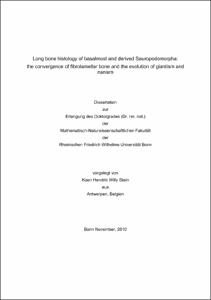Long bone histology of basalmost and derived Sauropodomorphathe convergence of fibrolamellar bone and the evolution of giantism and nanism

Long bone histology of basalmost and derived Sauropodomorpha
the convergence of fibrolamellar bone and the evolution of giantism and nanism

| dc.contributor.advisor | Sander, Martin P. | |
| dc.contributor.author | Stein, Koen Hendrik Willy | |
| dc.date.accessioned | 2020-04-17T09:15:55Z | |
| dc.date.available | 2020-04-17T09:15:55Z | |
| dc.date.issued | 11.01.2012 | |
| dc.identifier.uri | https://hdl.handle.net/20.500.11811/5073 | |
| dc.description.abstract | This study reports on long bone histology and growth in sauropodomorph dinosaurs. Derived members of Sauropodomorpha, the sauropods, were the largest terrestrial animals our planet has ever seen. New methods have recently allowed a much better sampling coverage, and provided a uniform view of uninterrupted laminar fibrolamellar bone (FLB) in neosauropods, but more basal sauropodomorphs remained unclear. Results in the current work indicate that FLB was already present in the earliest sauropodomorphs. Saturnalia, one of the most basal sauropodomorphs, clearly shows FLB in its long bones, albeit with growth marks. These marks represent interruptions of the animal’s growth, and are also present in other basal sauropodomorphs like Thecodontosaurus and Plateosaurus. This confirms earlier studies that sauropods accelerated their growth rates, most likely made possible by the preadaptive presence of high basal metabolic rates. FLB in mammals probably evolved as a convergent feature. Osteocyte lacuna densities and sizes suggest that sauropodomorphs and mammals employed different cell strategies to build bone tissue. However, a conclusion that FLB originated in a single archosaur or archosauromorph ancestor of sauropodomorphs and saurischians in general needs further testing. Long bone microstructure thus partially accounts for how these animals grew to giants, or became dwarfs in some cases. Sauropods namely secundarily evolved small sizes on islands. Here we provide strong evidence that the titanosaur Magyarosaurus dacus from the Cretaceous of Romania is not a juvenile of the larger ‘M.’ hungaricus . M. dacus individuals are histologically mature and have a different ontogenetic trajectory than ‘M.’ hungaricus. The histology of M. dacus is different from Europasaurus, a basal titanosauriform island dwarf from the Late Jurassic of Germany. The more intense secondary remodelling of M. dacus may be explaned by peramorphic heterochrony, possibly coupled with increased pneumatization in Titanosauria. The selective forces behind the progenetic dwarfing (a form of paedomorphosis) probably include the absence of large predators, and insufficient resources to provide for a healthy population of very large sauropods, and dinosaurs in general. Other dwarfed dinosaur species from the Hatzeg Basin like the ornithopods Zalmoxes and Telmatosaurus confirm this hypothesis. | en |
| dc.language.iso | eng | |
| dc.rights | In Copyright | |
| dc.rights.uri | http://rightsstatements.org/vocab/InC/1.0/ | |
| dc.subject.ddc | 560 Paläontologie | |
| dc.title | Long bone histology of basalmost and derived Sauropodomorpha | |
| dc.title.alternative | the convergence of fibrolamellar bone and the evolution of giantism and nanism | |
| dc.type | Dissertation oder Habilitation | |
| dc.publisher.name | Universitäts- und Landesbibliothek Bonn | |
| dc.publisher.location | Bonn | |
| dc.rights.accessRights | openAccess | |
| dc.identifier.urn | https://nbn-resolving.org/urn:nbn:de:hbz:5N-27140 | |
| ulbbn.pubtype | Erstveröffentlichung | |
| ulbbnediss.affiliation.name | Rheinische Friedrich-Wilhelms-Universität Bonn | |
| ulbbnediss.affiliation.location | Bonn | |
| ulbbnediss.thesis.level | Dissertation | |
| ulbbnediss.dissID | 2714 | |
| ulbbnediss.date.accepted | 17.03.2011 | |
| ulbbnediss.fakultaet | Mathematisch-Naturwissenschaftliche Fakultät | |
| dc.contributor.coReferee | Martin, Thomas |
Dateien zu dieser Ressource
Das Dokument erscheint in:
-
E-Dissertationen (4398)




